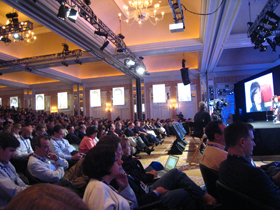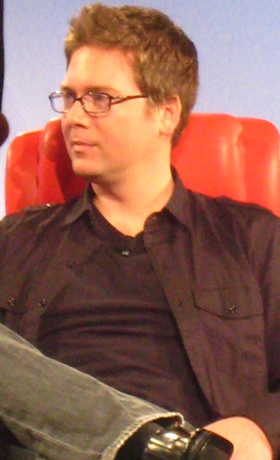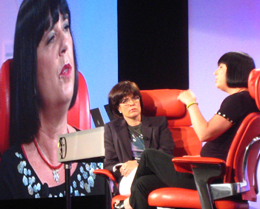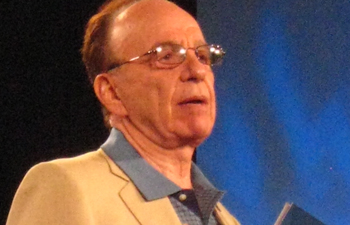
CARLSBAD, CALIF. — The organizers of the tony, high-priced tech conference known as D All Things Digital, included a manifesto of sorts in the program guide titled “Welcome to Web 3.0.” In that treatise, organizers Walt Mossberg and Kara Swisher define Web 3.0 as “the real arrival, after years of false predictions, of the thin client, running clean, simple software, against cloud-based data and services. The poster children for this new era have been the Apple iPhone and iPod Touch…”
While many people define Web 3.0 as part of the semantic web where machines will talk to machines and the dream of intelligent agents will come true, the D folks are more inclined to consider the handheld computer/smartphone revolution to be the center of Web 3.0. Why? “We are declaring the Web 2.0 era over, because, well, when you run conferences and websites, you can say stuff like that,” they wrote.
In years past, the D conference was known for charging thousands of dollars to attendees to come to a 5-star resort in Carlsbad and hear Mossberg and Swisher grill the titans of technology such as Bill Gates, Steve Jobs and Larry Ellison. They asked tough questions, the halls were packed with tech executives making deals and playing golf, and the Wall Street Journal (which owns the conference) made a few million dollars and was happy. But nothing in the technology business can stay static over seven long years (a lifetime on the Internet) so for D7, they were trying to make the transition to the post-Gates, post-Jobs era.
First problem with that move: No one spoke on stage from Apple Inc., the so-called poster child for the handheld revolution. That’s understandable as Jobs has been in poor health, but still, it’s surprising that no one else from Apple could come to talk about how the iPhone has literally changed the way people use cell phones to access the mobile web. Yes, there were chiefs from Nokia, Research in Motion and Palm, but the Apple no-show was glaring.
UPDATE: Swisher told me later that they tried to get Apple execs to speak but they declined. in that case, why not have someone who could talk about the iPhone platform such as a maker of a popular iPhone app?
Not Quite Open
Another problem at D was the uncertain contract between conference organizers and the press and bloggers covering the event. I was told in advance by Swisher that I would not be allowed to do live-blogging in transcript form. (Swisher did, however, say that people were allowed to use cell cards on their laptops.) Usually, I attend conferences and try to provide a running commentary on what people on stage are saying, largely paraphrasing what they say. It seemed like the D folks were against that idea. Like in the past seven D Conferences, organizers also didn’t provide WiFi Internet access in the main hall.
A long page in the program guide titled “D7 Press Coverage and Wireless Coverage” laid out the complex rules around covering the event:
Attendees may not record sessions on video or audio, as some speakers have declined to give us rights to such recordings. And in cases where speakers have given us the rights, we consider the audio and video content of D to be copyrighted. Similarly, while we respect ‘fair use’ reprinting of short text quotes, we consider full transcripts of the conference to be our intellectual property, not for publishing or posting by others…
We have opted against providing WiFi in the Grand Ballroom at D7. We make this choice in order to avoid the syndrome we have observed at so many conferences, where attendees spend the sessions sending email and web surfing, rather than fully engaging with the speakers. As an alternative, we have made available free Internet-connected PCs outside the Ballroom. While we realize this decision may impose a hardship on real-time bloggers, it isn’t aimed at preventing blogging, which we welcome.
It’s important to understand this policy in the context of the first D conference, where the organizers tried to make all sessions “off the record” with only Wall Street Journal reporters being able to blog and cover them. They took a lot of heat for that, and opened up subsequent conferences to bloggers and media coverage more, which I applaud. And PaidContent’s Staci Kramer told me she was still able to do live-blogging in the main hall with a broadband cell card on her laptop.
“It might seem like a restrictive policy to you,” she said, “but it’s all relative. Other conferences are even more hostile to people live-blogging and I think these guys are trying to open it up somewhat.”
Kramer explained that the reaction against transcript blogging came after one person really did post full transcripts from the conference. I get that. However, putting in restrictions against WiFi in the main hall didn’t stop about every fourth person in the room from being on their smartphones and texting people and doing email. It was ironic that attendees were using the very technology of Web 3.0 to be distracted during most speakers — the very thing the organizers didn’t want.

Even more ironic was the rule against videotaping sessions when everyone was given free Flip HD videocameras in their “schwag bags.” Kramer told me that in her opinion shooting brief videos was actually kosher as long as they didn’t go on too long. D should be complimented on providing official videos from the sessions very quickly afterward. D Conference also plans to have videos of the full sessions posted online in the coming weeks.
Conference Highlights
D7 tried to straddle between the new guard such as Twitter founders, MySpace execs and Mozilla honchos taking the stage and the older guard such as Microsoft CEO Steve Ballmer, Liberty Media mogul John Malone and Ticketmaster CEO Irving Azoff.
In fact, the Twitter founders, Evan Williams and Biz Stone, were the first speakers on Tuesday night. Unfortunately they provided little insight into plans for a business model, no real news, and Williams admitted he had never run a company like Twitter before. Talking to other D attendees afterward, I found that they were generally unimpressed by the Twitter honchos, who admitted their business model was “we don’t know” and said they would refuse to sell out to Google or anyone, and wanted to build the business for 5 years as an independent company.
Gadget guy Mike Foley wrote this on his Twitter feed about the Twitter chat:
The Twitter guys at #D7 sucked on stage. Need to have something to say or stay home. Walt [Mossberg] too insulting. Bad theater.
Even worse, some of the humorous bits and videos that D put together came off as flat, and people were often groaning more than laughing. Only when Jill Sobule did a spoof song about her meeting with Rupert Murdoch did the crowd roar with delight.
Probably the most entertaining speaker at the conference was new Yahoo CEO Carol Bartz, who outgunned Swisher with humor and straight-shooting talk about the problems at the stumbling web giant. When someone asked her about Yahoo’s TV efforts, she admitted she didn’t know much about it. It’s a rarity to hear a CEO admit there’s something they don’t know. Here’s a video of some of the highlights of her talk with Swisher:
Another positive for the conference is the amazing smarts of the people in the room. When you head to dinner or lunch, you know that the people sitting around you at tables have a lot of know-how when it comes to technology and those discussions are a highlight of D. The organizers are smart to provide lots of opportunities for networking, from coffee breaks to meals to nightcap meetups.
At one point, Swisher noted on stage just how smart the people in the audience are and said, “We could do a whole conference just about you all.” So why don’t they? There are so many ways that D could incorporate more audience participation beyond 10 minutes of audience questions after each speaker — and they often insult the questioners for making statements rather than asking questions, although in at least one instance Mossberg apologized afterward. Why not highlight the backchannel on Twitter, take questions by text message, or have smaller moderated discussions take place in rooms outside the main hall? Those would make the conference at least more embracing of Web 2.0, if not Web 3.0.
UPDATE: Swisher said that past D Conferences had allowed the audience to text questions, but the organizers had decided against that this year.
AT&T Protests and Ensler’s Missing Audience
There were a few other unsettling things I experienced at D this year. During the talk by AT&T’s CEO Randall Stephenson, a group of protesters were outside the road to the Four Seasons Resort Aviary. They were upset that AT&T was making billions in profit but were asking union workers to take a pay and health benefits cut. I talked with the protestors and here’s a video of one of them explaining why they were protesting:
Unfortunately their concerns were not raised during Stephenson’s talk and I didn’t make it inside in time to ask a question myself. The union doesn’t have a contract with AT&T and says the telecom giant wants to make them pay 30% of their health care costs. Similar union protests have been happening around the U.S.
D also looked beyond the typical tech titans by having Eve Ensler of “Vagina Monologues” fame come on stage and talk about her V-Day efforts to stop violence against women. Ensler explained how militias in the Congo raped women in front of their husbands in order to take control of mines that produced coltan, a common component of cell phones and iPods. Ensler didn’t ask for a boycott but wants electronics companies to monitor the mines where they get materials and perhaps offer “rape-free” products that don’t include materials from sketchy situations.

Ensler gave a very powerful and moving talk on an important topic that needs more attention. But while many were enraptured by her words, others found her out of place in a conference on technology. Sadly, when Ensler began to chat with Swisher, about 20% to 25% of D attendees headed for the exits, talking with their feet about how much they cared about this issue. One attendee told me later that he didn’t appreciate Swisher using the conference as a political platform. “I know it’s an important cause, but I came here for the technology, not that.”
Conclusion
I think D is definitely in a transitional period, just as the technology and media companies are dealing with digital disruption. Do they want to remain a relatively closed conference focused on the titans of technology on stage or do they want to become more open to how people cover the conference, how attendees can participate and who they put on stage?
They will need to change with the times, update their format and become more open to the ideas of all the attendees, or face the prospect of dwindling attendance or relevance. D has a winning formula for bringing together top execs in the tech industry and letting them schmooze and make deals. Organizers say they have done well with attendance and don’t think it will drop off — that the conference apparently gained attendees in a bad economic year may speak to the strength of its model. But I think they need to take the stage show up to the next level if they are going to keep people coming back.
What do you think? Did you attend D and enjoy it or think it could be improved? Share your thoughts and highlights in the comments below.
UPDATE (12:05 PM EDT 6-01-09): We received an email response from Kara Swisher about this post and have correcting the record above with updates where noted.


Mark, as an attendee, I a have lots of quibbles with your article but do appreciate that you did a thoughtful critique of the event. Many of the tweets from the event were just factual summaries of what were said (as I imagine a live blog would be). I’d rather read an article like yours with analysis a day later.
The one area that I do want to address is Ensler’s talk. As an attendee I DO appreciate that Kara choose to bring this issue to our attention. I just found it a shame that it was scheduled as the last item before a lunch. It would have been great to see it sandwiched between two anticipated speakers so more people would have heard the message.
Unfortunately, as good as Ensler was at presenting the problem, she was equally as bad at proposing a solution. She made a good case for why not a boycott but never really explained what a comprehensive solution should be. I’d rather have heard her just say, “there are many activists working on this problem and if I have opened your company’s eyes to it, please seek them out and get involved with their efforts.”
Good article. First one I’ve seen that addresses some of the issues with the $6000 conference. I’ve been to every one since the first D.
What bothers me is the notion that Kara and Walt are the attraction, rather than the titans on stage and the brilliant people in the audience. Most of the interviews, especially the Twitter duo, Kara and Walt spoke more than the interviewees. I don’t care about Kara’s mom, her sexual preference, or her kid – all of which feature prominently in each conference. Last year they even had a birthday cake for themseleves!!!! Enough. Take a lesson from a pro like Charlie Rose…. ask great questions, then fade into the background.
At first I thought this post was too long. But after i took the time to read it and watch the videos I found it to bring a very comprehensive look at the conference. I will be looking forward to your next report.
With respect, Mark, I have some serious issues with your post. Not only are there some rather substantial factual errors, I’m a bit more than put off that you neglected to talk with any of the many folks who *did* stay in the room during Eve’s talk and who were impressed and even motivated to do something about the dire issues about which she spoke.
I also think that whomever the coward is who opted to speak of this being a “political” issue and didn’t want to be identified should strap on a pair and identify himself. Anyone who thinks that what’s happening in the Congo is a “political” issue rather than a HUMAN RIGHTS issue should have their head examined.
Thanks for the thoughtful post Mark – and for reporting on the AT&T union matter.
There’s one more problem with the whole web 3.0 mindframe.
It puts the emphasis on the technology — whether it be a gadget or a digital search butler – rather than the human element!
For me — the whole next version web must be about baking trust into this evolving digital world. For me — it should be called Trusted Web.
That’s the name I’m trying get to stick. Wish me luck ;)